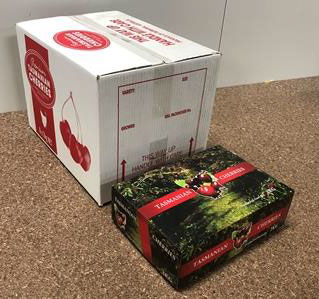FA cooling does not require produce to be packed in water-resistant containers although it can cause water-loss and dehydration in some situations.
Box design (cont from last issue)
Since almost all cherries are sealed in polyethylene bags, this potential water loss is usually not an issue. One of the greatest advantages of tunnel style cooling is that most container types are suitable so long as there are enough side vents, and these vents line up through the pallet.
There are many factors that affect the rate of cooling in a FA system, including fan size, air leakage, density of produce in pallet and the packaging container used.
Fruit cools faster if the air can pass uniformly through the pallet. Produce to be cooled using tunnel style forced air should be designed with several factors in mind:
• Vent size and shape should not allow vents to be blocked by produce (avoid small and round vents in the case of cherries).
• Use few large vents as opposed to many small.
• Vents should be at least 1cm wide.
• Vents should be 4-7cm away from box corners.
• Total vent area should be at least 5% of the side area of the pallet.
Aussie cherry boxes
With these factors in mind, current boxes used by the Tasmanian cherry industry are completely unsuitable for any style of post-packing cooling.
Most producers use a solid two-piece box where fruit is packed into a modified atmosphere (MA) bag within a 1, 2 or 5kg sized cardboard base. The bag is then sealed and a cardboard lid is placed over the top with these boxes then placed inside a larger cardboard outer (Figure 1).
As well as providing good structural strength, these boxes are predominantly designed for the gift market. Due to the close proximity of the Tasmanian harvest season to Lunar New Year, this gift market is a lucrative one as many Chinese consumers purchase Tasmanian cherries in these 1 or 2kg boxes to give to friends and relatives.
Packing directly into this packaging means that fruit will not need to be repacked in Asian markets and helps to maintain the consumer perception of Tasmanian cherries being of a premium standard and quality.
Inability to cool packaged fruit (cont next issue)
See this issue in Tree Fruit June 2022






















